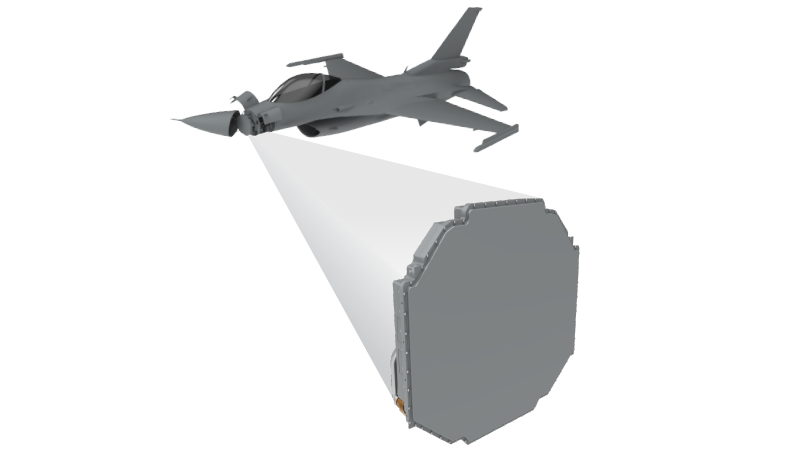MURAD 100-A is a fire control radar utilizing Active Electronically Scanned Array (AESA) technology. This system enables modern combat aircraft to achieve high-precision target detection, tracking, and engagement in both air-to-air and air-to-ground missions. With its AESA architecture, MURAD 100-A offers significantly faster and more efficient performance compared to traditional mechanically scanned radar systems. It stands out with its wide frequency band, electronic beam steering, and digital beamforming capabilities.

MURAD 100-A
Technical and Functional Features
MURAD 100-A is designed to meet the demands of modern aerial combat, incorporating advanced semiconductor technology and digital signal processing to enhance operational effectiveness.
1. Wide Frequency Band
The radar's wide frequency band allows it to operate in diverse electromagnetic environments and enhances its resilience against enemy electronic warfare (EW) measures. This broad frequency range increases resistance to jamming while enabling its use in various mission profiles.
2. Electronic Beam Steering in Azimuth and Elevation
Unlike mechanical scanning systems, MURAD 100-A features electronic beam steering, allowing it to detect targets rapidly without the need for physical antenna movement. This capability enables simultaneous tracking of multiple targets and provides a significant advantage in high-maneuverability combat scenarios.
3. GaN (Gallium Nitride) Power Amplifiers
MURAD 100-A employs Gallium Nitride (GaN) power amplifiers, which offer high efficiency and durability in radar systems. GaN technology enables the radar to operate at longer ranges with lower power consumption while improving thermal management, thereby increasing operational endurance.
4. Graceful Degradation Feature
Ensuring reliability and continuous operation is critical in radar systems. MURAD 100-A’s graceful degradation feature prevents complete system failure in the event of component malfunctions, allowing it to continue operating at reduced capacity. This feature is a crucial advantage in combat conditions, ensuring mission continuity.
5. Digital Beamforming
With its digital beamforming capability, the radar offers more precise and flexible scanning compared to traditional radar systems. Digital processing technologies enable simultaneous detection and tracking of multiple targets. This capability provides a critical advantage in modern air combat environments, where multi-target engagements are common.
Air-to-Air and Air-to-Ground Capabilities
MURAD 100-A is designed for effective use in both air-to-air and air-to-ground missions.
1. Air-to-Air Capabilities
- Long-range target detection and tracking: The AESA architecture allows the radar to detect low-observability targets at extended ranges.
- Multi-target tracking and engagement: It can track multiple aerial targets simultaneously and provide missile guidance support.
- Low Probability of Intercept (LPI): The radar’s emissions are designed to be harder to detect by enemy radar warning receivers, reducing the likelihood of platform detection.
2. Air-to-Ground Capabilities
- High-resolution ground target detection: The radar can detect and track both stationary and moving ground targets.
- Synthetic Aperture Radar (SAR) imaging: It facilitates high-resolution terrain mapping, improving target identification.
- Precision-guided weapon support: The radar enhances weapon accuracy by precisely determining target coordinates.
Operational Advantages and Applications
The technological innovations introduced by MURAD 100-A provide numerous advantages that enhance the operational effectiveness of combat aircraft.
- Rapid and Flexible Target Detection: The AESA architecture allows the radar to conduct high-speed scans with minimal latency, enabling early threat detection.
- Resistance to Electronic Warfare and Countermeasures: Designed to withstand enemy electronic warfare attacks, the radar adapts to countermeasure techniques.
- Modular and Integrated Structure: Its modular design facilitates integration into various platforms, making it compatible with different aircraft types.
- Low Maintenance Requirements: As it does not include mechanical scanning components, the radar is less prone to wear and tear, reducing maintenance downtime and operational costs.
MURAD 100-A AESA Fire Control Radar stands out as an advanced system that meets the requirements of modern aerial combat with its high-resolution detection and tracking capabilities. Equipped with cutting-edge technologies such as a wide frequency band, electronic beam steering, digital beamforming, and GaN power amplifiers, this radar enhances the reconnaissance, surveillance, and engagement capabilities of air platforms.
By providing exceptional precision and durability in air-to-air and air-to-ground operations, MURAD 100-A significantly improves the combat effectiveness of modern fighter aircraft. Its resilience against electronic warfare, ability to track multiple targets, and adaptability to a wide range of mission profiles make it a highly capable solution for future combat concepts. The integration of this system into air platforms represents a crucial step in ensuring air superiority in modern warfare. The flexibility and speed offered by AESA technology make MURAD 100-A a radar solution that can adapt to evolving threat environments.

